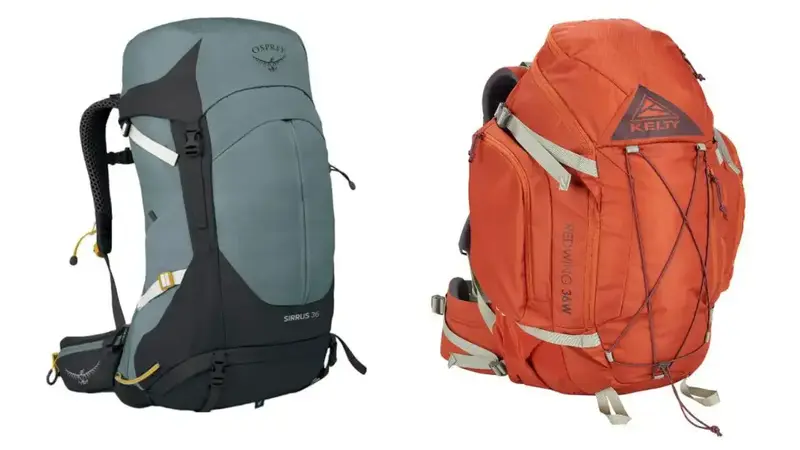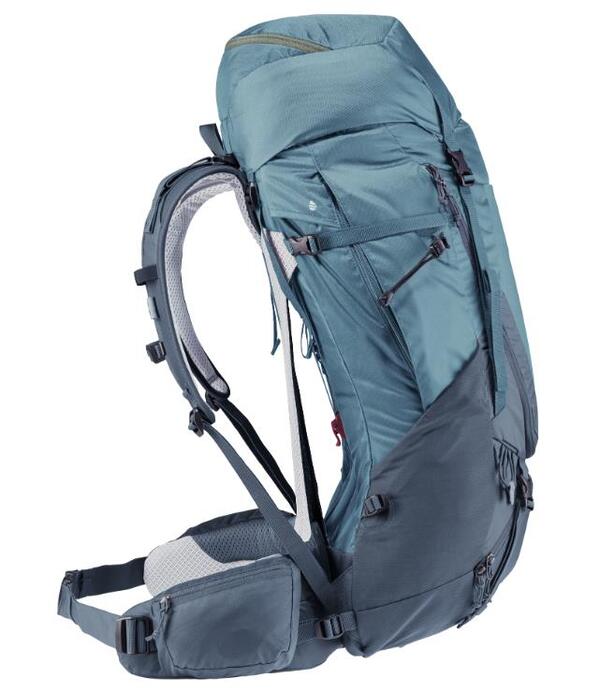Backpack’s volume capacity and weight capacity are very different features. The former can be measured and it is exact. The latter is based on technical durability and on comfort level and therefore it is never exact.
Specifications of a backpack include parameters like weight capacity (or carry load), and volume capacity (or simply capacity).
These terms may sometimes be mixed but they describe completely different aspects of a pack, and they have nothing to do with each other.
The volume describes the total inner size of all cavities of a pack, and it is given in liters or in cubic inches. In principle, this parameter you can determine yourself or rely on what specifications of a pack show you.
The weight capacity is a parameter that describes the maximum load (in kilograms or pounds) that you can carry comfortably in one specific pack. So this has lots to do with the construction of the pack, its frame, padding, hip belt presence or absence, etc.
However, the feeling of comfort is individual, yet weight capacity comes in specifications, so it is determined externally. How? By load testing for pack’s structural durability, and by some “average” or “typical” testing people. This is why it is not truly reliable and it should not be taken very strictly.

How to determine the weight capacity of a backpack?
The answer to this question is simple – put some extremely heavy stuff in the pack and carry it around. Ask somebody to keep adding weight till the shoulder harness straps tear off and break apart.
I am joking of course. But seriously, you do not determine the weight capacity of a pack. This parameter is normally given in specification for almost every pack of top brands.
Here I have to correct myself. Surprisingly enough, Deuter is the top brand, but you will not find such information in specifications of their packs. Once, I asked about one specific pack, and they replied that they simply do not provide it.
But knowing how reliable Deuter packs are, you can simply compare it with some other brand’s pack of the same volume where the weight capacity is given. You can be sure that Deuter’s pack will be able to support at least the same weight. So its carry load will be at least the same or more likely better.
Weight capacity elements
There are quite a few, and they include the backpack’s design, materials, and intended use. Here’s how manufacturers and experts typically evaluate and determine this capacity:
1. Frame design and strength
Internal or external frame: Backpacks with robust internal or externals frames can allow users to carry heavier loads more comfortably than frameless models.
Apparently, frames themselves are usually tested for structural integrity under specific weight loads.
Frame materials used: The material of the frame (e.g., aluminum, carbon fiber, or plastic) plays a critical role in how much weight the backpack can bear without bending or breaking.
2. Suspension system
Shoulder straps and hip belt: The quality and adjustability of the straps and hip belt determine how much weight can be comfortably distributed. A well-designed suspension system shifts most of the load to the hips, enabling higher weight capacity.
Load-lifting mechanisms: Features like load lifters and stabilizer straps are tested for their ability to keep the load balanced and reduce strain on the user.
3. Material durability
Fabric strength: The backpack’s fabric, such as ripstop nylon or Cordura, is tested for its ability to resist tearing under weight stress. Denier ratings indicate fabric thickness and durability (e.g., 500D is sturdier than 210D).
Zippers and stitching: These components are evaluated for their strength under strain, as they are critical to maintaining the integrity of the pack under heavy loads.
This durability aspect is far more important for very large packs than for day packs.
How they test packs for weight capacity?
Mechanical load testing
From what I find around, it appears that manufacturers use stress tests to simulate real-world conditions, and they include:
- Dynamic testing: Backpacks are loaded with weights and subjected to repetitive motion, such as walking or bouncing, to mimic hiking conditions.
- Static testing: Backpacks are loaded with increasing amounts of weight to determine the point at which seams, straps, or the frame fail.
Testing for comfort and practicality
This is the aspect where things become non-exact. Manufacturers consider ability of an “average person” to carry the load.
Even if a backpack can technically hold 80 pounds, most hiking packs are designed for comfort with loads between 20-60 pounds, depending on the user’s size and fitness level.
This is all fine, but “average person” is far from easy to define, we are all different. In the end, this is always about your personal comfort level, but see the “testing” in this funny video:
But what is a pack’s weight capacity? How much weight can a backpack really hold?
It is best to take some examples:
- My Osprey Stratos 24 pack (shown in the top picture above): official carry load range is 10-25 lb (5-12 kg). Observe the strange lower limit here.
- Gregory Katmai 55 pack for men: official load capacity is 45 lb (20.4 kg).
Now, what is the meaning of this? Does this mean if you have 25 kilograms in your Katmai pack that it will fall apart? Of course not.
The meaning is that some “average” or “typical” person (but not necessarily you) can carry up to 45 pounds (20.4 kg) comfortably. Observe those 0.4 kg and think if this is really a big deal. Could you set the carry load to 44 pounds (20 kg)? Of course you can, there is nothing exact here.
I am sure you can carry 30 kilograms in the pack at least for a while, the pack will be fine, yet I am not sure how this would be with you. So you see the point?
But what about the mentioned lower limit in my Osprey pack, those 10 pounds (5 kg)?
Frankly speaking, I have no idea what they mean by this. I have used that pack many times with just a few items inside, so this was well below the mentioned lower carry load limit.
My guess is that this may have something to do with how the pack’s harness wraps around your body under an appropriate load. So if the weight is too small, it may not hug your body in an optimal way, or something along this line of thinking.
Or perhaps the explanation is as follows. If you know you will be carrying less than 10 pounds (5 kg) in the pack, then perhaps it is better that you choose a pack with less padding and even without the hip belt. It will be much lighter and it will be good enough to do the job for you.
Nevertheless, I am sure it is best to disregard this parameter, in my view it has no real practical meaning.
Now, what is volume capacity of a pack?
Once, I received a comment here in the site by somebody asking about a large 60 liters pack something like ‘are you really so strong to carry 60 liters in the pack?’.
The person was clearly wrongly thinking in terms of weight, while this was about volume.
If a pack would be a rectangular object, its volume would be simply the product of its three dimensions (height, width, and length). As you know packs usually come with such dimensions indicated, but this cannot be used to determine volume.
The reality is that a pack has no regular shape. Quite generally, volume capacity or simply capacity refers to the inner dimensions of all its cavities, and this means inner compartment(s) and pockets.
So this is about bulk of the pack when all its cavities (including the lid as well) are filled with stuff. Now, you can fill those compartments and pockets with something very light to measure the volume, and, consequently, this has nothing to do with carry load weight.
In other words, a 50-liters pack does not necessarily mean that you can carry 50 kg of weight in it.
How is a pack’s volume measured?
I admit, I do not have a precise information on how various brands determine the volume capacity or volume of their packs. But from what I read, this is determined through standardized testing methods to measure the total usable space within the pack.
Several backpack brands adhere to ISO standards, and they include Fjällräven and Camelbak. I could not find any info regarding bigger brands like Deuter and Osprey.
In any case, this is something that can be measured, so this is more or less an exact parameter.
One simple way would be to use some small identical objects that would be used as units of volume, assuming that we know exactly individual volume of each of them. Imagine that these are simple balls with 1 cm diameter.
The volume of such a ball is then 3.14/6 cm³ = 0.52 cm³. But when these balls are packed together and they are in contact with each other, each of them will need around 1 cubic centimeter of space (volume).

Now fill the pack, check how many balls fit in (say this is N balls), and the volume in cubic centimeters will be very close to N. Easy!
Then you can recalculate, 1 liter equals 1000 cm³ (i.e., 1000 balls), and this equals 61 in³.
This is a bit rough estimate, and this is probably the minimum volume of the pack. You can use some other size balls, for example those that are used for table tennis or tennis. It is important that they are all identical and that you know the diameter.
In this video you can see how people at REI measure the volume of a pack:
You can also put some waterproof plastic sack in the pack and fill it with water. Then measure the weight of this water, 1 kg is 1 liter, so you will know very exactly the volume of the main compartment. But think about pockets and other compartments.
There are some other clever ideas, see one here:
Why is the capacity of backpacks always measured in liters?
This is a real question that I have seen as being asked, and I can only say it is misleading. In the US area, backpacks volume capacity is mostly given in cubic inches.
As mentioned above, you can easily recalculate, one liter corresponds to 61 cubic inches.
Related to volume capacity: important things to consider as a user
The shape of the pack can affect how the space is utilized, even if the measured volume is the same. For example, a tall, narrow pack may fit differently compared to a short, wide one.
This might be obvious when you see the two packs in the picture below, on the left is Osprey Sirrus 36 and on the right is Kelty Redwing 36. These are truly excellent packs, but they follow very different design concepts.

Also, are you familiar with ventilated packs? Well, this is a great design, but the frame in some of these packs is curved to create a gap between your body and back panel. As a result, the main compartment is also shaped by this, so larger items may not fit inside easily.
To understand better what I am saying, have a look at the pack below, this is the side view of a Deuter Futura Air Trek pack:

Internal frame presence in general might affect fit of larger equipment items, so you may have a feeling that the pack is smaller that what its specifications tell you.
Weight vs volume in practice: How much weight can a 30 L backpack hold?
I have seen a number of questions of this type, for a variety of volumes, not only for 30 liters packs. In fact, this and similar questions reflect the real issue, people get confused with the volume and the carry load capacity.
So to properly answer this particular question, this is about a backpack that has a volume of 30 liters. Now, the actual official carry load of such a pack will depend on its construction and on the quality of the pack in general, and on their testing people as mentioned above.
Let’s see some examples.
- Gregory Mountain Products Icarus 30 Liter Kid’s Hiking Backpack has an official 20 lb (9.1 kg) load capacity.
- Gregory Zulu 30 Pack, 40 lb (18 kg).
- Mountainsmith Scream 30 Backpack, 30 lb (13.6 kg).
So as you see, there is no strict rule, all three packs have the same volume, but the official weight capacity is very different. As I said earlier, this is about carrying the weight comfortably, so this is both about the pack and about you.
Conclusion
In summary, backpack’s volume capacity and weight capacity are two different features of a pack, and I hope I was able to explain this topic clearly.
The weight capacity of a hiking backpack reflects both its technical durability and the practical comfort limits of users. Manufacturers balance rigorous testing with ergonomic considerations to provide a realistic weight range for different hiking scenarios.
The volume capacity of a hiking backpack is determined by physically filling and measuring all usable compartments using a standardized procedure. This ensures consistency and provides an accurate estimate of how much gear the backpack can hold for hiking and camping purposes.
Let me know if I missed to say something important or if I said something that was not clear. There is a comment box below.
More about outdoor equipment questions and answers you will find in the category FAQs here in the site. But check also my text about specifications of a good pack and about sweating with a pack.
Subscribe to my weakly newsletter and stay informed, the subscription form is given below. Thank you for reading and have a nice day.
Leave a Reply